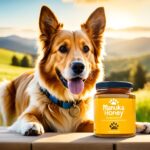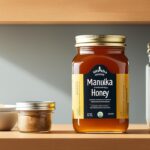Deep within the verdant forests of New Zealand, a natural elixir is crafted with such meticulous care, it’s often hailed as liquid gold. Manuka honey production is not just an agricultural task; it embodies an ancient bond between bees and their keepers, revolving around one of the world’s most praised and healing nectars. The beekeeping techniques employed to harness the healing properties of honey have developed over centuries but remain rooted in a profound respect for nature and its complex systems. In this introduction, we’re about to unravel the mystique that surrounds the coveted Manuka honey and the devoted beekeepers who are the unsung heroes behind each golden drop.
The journey from beehive to healing hive product involves a symphony of nature and nurture, demanding more than just traditional apiculture methods. It’s a fascinating blend of science, art, and a bit of personal alchemy that has positioned Manuka honey at the apex of natural remedies. As we delve deeper into the world of Manuka honey production, prepare to be enthralled by the passion, precision, and sustainable practices that define this unique craft. This is a story as rich and layered as the honey itself, so let’s embark on this sweet voyage together.
Introduction to Manuka Honey and its Unique Qualities
Manuka honey, produced from the nectar of the Manuka tree, native to New Zealand, represents a pinnacle in the world of honey with unique benefits that surpass those of conventional honey. It is touted not just for its distinctive, rich flavor, but for its compelling health benefits that stem from its potent antimicrobial properties. Renowned globally for its quality and effectiveness, Manuka honey holds a unique position in both health and wellness circles.
One of the hallmarks of Manuka honey is its Unique Manuka Factor (UMF) rating. This grading system measures the presence of particular compounds such as methylglyoxal (MGO), dihydroxyacetone (DHA), and leptosperin, which are responsible for its antimicrobial strength. The higher the UMF rating, the stronger the honey’s antibacterial properties, making UMF a crucial indicator of quality for consumers seeking the therapeutic applications of Manuka honey.
| UMF Rating | Antimicrobial Potency | Common Uses |
|---|---|---|
| 0-4 | Minimum | Culinary purposes, general sweetening |
| 5-9 | Moderate | Natural remedy for digestion, energy boost |
| 10-14 | High | Skin care, wound care, sore throats |
| 15+ | Superior | Targeted therapeutic use, immune support |
The unique benefits of Manuka honey go beyond its ability to fight bacteria. Its consistent texture, unparalleled shelf-life, and the extensive care taken during harvesting set it apart from other varieties. These characteristics have led to its endorsement by health experts and prompted rigorous scientific studies to explore its full potential.
- Rich in antioxidants
- Enhances wound healing
- Soothes a sore throat
- Improves digestive symptoms
- Boosts vitality and well-being
As we continue to uncover the remarkable capabilities of this natural resource, the global appreciation for Manuka honey solidifies. The combination of its unparalleled antimicrobial properties and UMF rating assures quality and efficacy, positioning Manuka honey at the forefront of natural health remedies and as a luxurious staple in homes around the world.
Origins and History of Manuka Honey Beekeeping
Tracing the roots of Manuka honey origins takes us to the pristine landscapes of New Zealand, a land renowned for its natural beauty and the birthplace of traditional Maori honey-gathering techniques. Initially, the indigenous Maori people recognized the healing properties of Manuka as they used the honey produced from wild bees for medicinal purposes.
The Western world’s discovery of New Zealand beekeeping practices transformed these traditions into a burgeoning industry. European settlers brought the Western honeybee to the area in the early 19th century, adapting traditional beekeeping practices to New Zealand’s unique ecology to maximize honey production. The evolution of these practices over time has had a profound influence on the modern techniques we see in Manuka honey beekeeping today.
| Period | Development | Impact |
|---|---|---|
| Early 19th Century | Introduction of Western honeybee | Foundation for commercial beekeeping |
| Mid-19th Century | Recognizing the medicinal benefits of Manuka | Increased value and traditional use of Manuka honey |
| 20th Century | Scientific research validating Manuka honey’s unique properties | Rise in international demand and scientific interest |
| 21st Century | Advancements in beekeeping and honey processing | Improved quality and efficiency in Manuka honey production |
The timeline above outlines the key historical milestones that chart the progression from indigenous knowledge to advanced production methods. It shows the journey of Manuka honey from a locally revered resource to an internationally acclaimed product. This rich history underpins the high standards and methods currently employed in New Zealand’s Manuka honey beekeeping industry, ensuring that this golden elixir retains its authenticity and healing prowess.
Understanding the Manuka Flower and its Ecosystem
The Manuka bush, or Leptospermum scoparium, holds a prestigious position within New Zealand’s lush flora. This native plant serves as the genesis of the globally acclaimed Manuka honey, produced when bees forage on its nectar-rich flowers. The intricate relationship between the Manuka bush and pollinating bees is a dance of ecological interdependence that propels the survival and prosperity of each. Let’s delve into the intricacies of this symbiosis and the plant’s significance within its native habitat.
Found in the wild, the Manuka bush flourishes across varying landscapes — from coastal regions to lowland forests — displaying resilience and adaptability. The bush’s ability to thrive in diverse environments contributes to its importance within New Zealand’s native plant communities. It is not merely a source of high-grade honey but also a cornerstone species, impacting ecological structures and processes.
- The Manuka’s distinctive white or pink flowers bloom between spring and summer, inviting a buzz of bee activity.
- Its robust nature aids in soil conservation, providing erosion control on precarious terrains.
- The bush serves as shelter and nourishment for various indigenous wildlife, underscoring its ecosystem value.
| Characteristics of Manuka Bush | Impact on Ecosystem |
|---|---|
| Dense, shrubby growth | Supports wildlife habitat complexity |
| Longevity and resistance to drought | Promotes sustained plant diversity |
| Virile natural regeneration | Facilitates recovery post-environmental disturbances |
The Manuka bush’s prominence in New Zealand extends beyond environmental benefits. Culturally and economically, the bush’s existence is interwoven with the prosperity of local communities, anchoring a thriving industry of beekeeping and herbal remedy markets. Knowledge of this plant, and the respect for its role, is paramount for the continued success of the Manuka honey industry and the protection of New Zealand’s precious ecosystems.
The Life Cycle of Manuka Honey Bees
Delving into the intricate world of beekeeping, the bee colony lifecycle presents a fascinating journey from the minuscule egg to the diligent forager bee. Each stage of development plays a pivotal role in the sustenance of the colony and the production of Manuka honey. By understanding this cycle, beekeeping management becomes a fine-tuned art, ensuring that beehives thrive through every season.
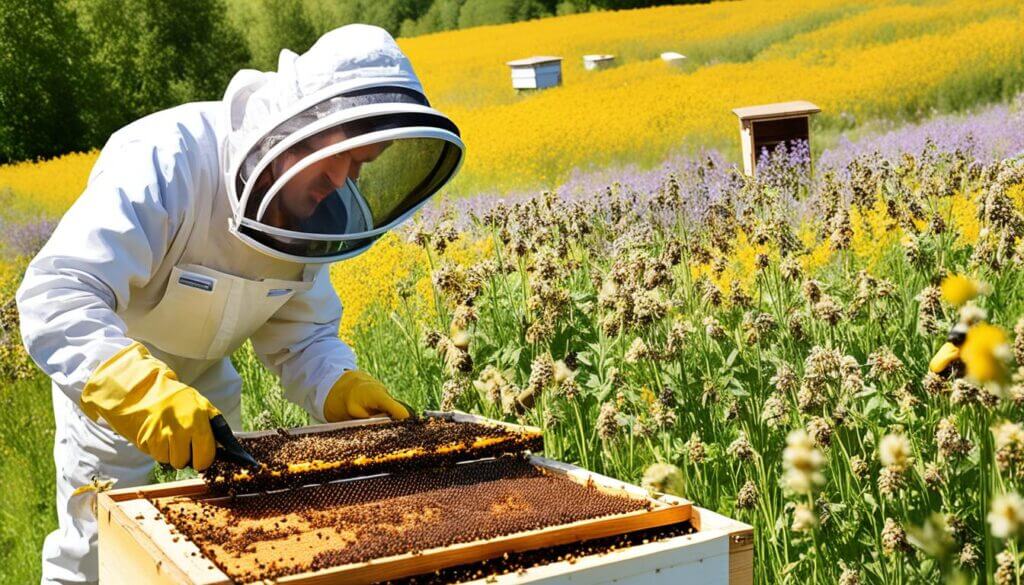
Beekeeping management is crucial in safeguarding the health of the bee colonies. Beekeepers must monitor various factors, including food availability, disease control, and hive temperature, to support their buzzing charges throughout their lifecycle stages. This entails a precise balance of care during the transition from larvae to pupae and finally, to mature bees. Notably, the pollination process is central to not only the survival of the bees but to the entire ecosystem, as it leads to the successful production of Manuka honey and supports biodiversity.
| Stage | Description | Duration | Management Practices |
|---|---|---|---|
| Egg | Queen lays the egg. | 3 Days | Ensure hive is conducive for egg-laying. |
| Larva | Larvae are fed by worker bees. | 6 Days | Optimize nutrition and control hive pests. |
| Pupa | Larvae develop into bees in capped cells. | 12 Days | Maintain proper hive humidity and temperature. |
| Adult Bee | Bees take on various roles in the hive. | Varies | Manage forage availability and support pollination process. |
In each phase, beekeepers harness their knowledge and skills to provide the most favorable conditions for their hives. From assuring abundant food during the larval stage to fostering an efficient pollination process by mature bees, the goal remains consistent: to facilitate the health and productivity of the bee colony for premier Manuka honey production.
Manuka Honey Beekeeping: A Seasonal Chronology
Beekeeping for Manuka honey is an art that syncs with the annual patterns of nature. As we delve deeper into the life of a Manuka honey beekeeper, understanding the seasonal beekeeping activities, hive maintenance, and the beekeeping calendar becomes paramount. Each season brings its unique set of tasks, designed to support the health of the colonies and optimize honey production. Below is a comprehensive guide that outlines the seasonal timeline of beekeeping tasks that are crucial for the production of premium Manuka honey.
| Season | Activities | Hive Maintenance |
|---|---|---|
| Spring |
|
|
| Summer |
|
|
| Autumn |
|
|
| Winter |
|
|
Through carefully planned and executed seasonal beekeeping activities and diligent hive maintenance, beekeepers help sustain the Manuka honey bees, ensuring the continued harvest of this unique natural resource. Adherence to the beekeeping calendar not only promotes the health and productivity of the bees but also maintains the exceptional quality of Manuka honey that is cherished worldwide.
The Harvest: Collecting Manuka Honey Ethically and Sustainably
In the realm of Manuka honey production, the harvest season is a critical time where the principles of sustainable beekeeping and the practice of ethical honey harvesting converge to protect the vital bee health. Beekeepers devoted to these practices often follow a set of standards designed to not only yield high-quality honey but also to safeguard the environment and ensure the wellbeing of their apiaries.
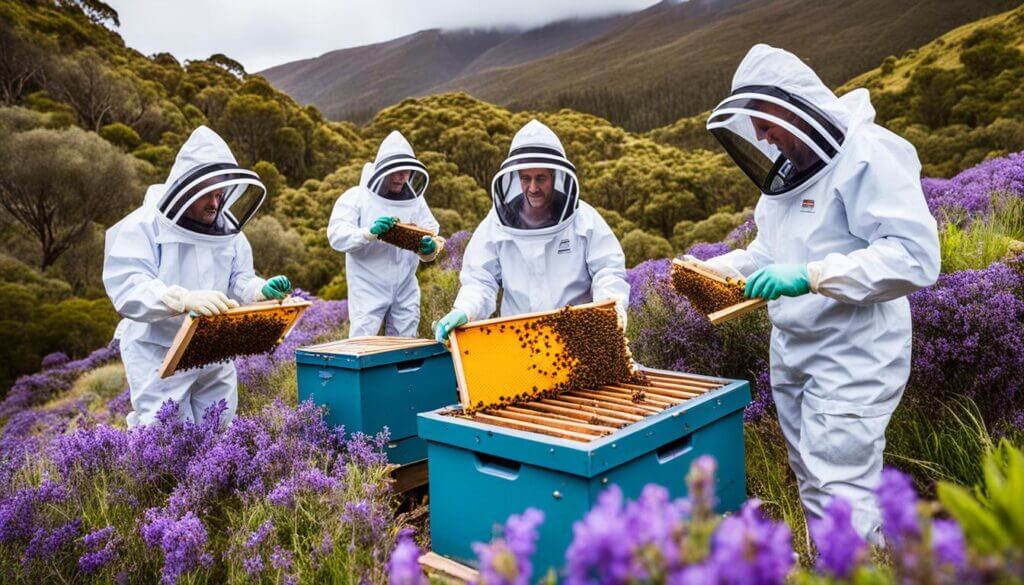
Modern beekeepers employ various methods that align with these ethical and sustainable initiatives. Utilizing gentle techniques for extraction and ensuring bees have sufficient stores of honey for their own sustenance are just the beginning steps. Let’s delve into a detailed guideline that outlines the proper approach to harvesting Manuka honey, with careful consideration of all involved stakeholders – the bees, the ecosystems, and the beekeepers themselves.
| Principle | Description | Benefits |
|---|---|---|
| Conservation of Bees | Leaving enough honey in the hive to sustain the colony. | Supports bee health throughout harvest months. |
| Non-invasive Techniques | Using low-impact methods to gather honey without disturbing bees. | Minimizes stress and promotes a thriving bee population. |
| Eco-friendly Equipment | Harvesting tools and containers made from sustainable materials. | Reduces environmental footprint and contamination of honey. |
| Responsible Land Management | Protecting and maintaining the natural habitat around the hives. | Preserves biodiversity and ensures a consistent food source for bees. |
| Community Engagement | Collaborating with locals to support sustainable practices. | Encourages sustainable livelihoods and knowledge sharing. |
To bring these principles to life, beekeepers may adopt an array of sustainable actions and gears such as:
- Use of solar-powered extractors to reduce energy consumption.
- Implementation of organic practices to manage pests and diseases.
- Education and training programs for beekeepers to promote best practices.
- Annual audits and certifications from recognized sustainable beekeeping organizations.
The adoption of these ethical harvesting tactics is seen as a commitment to the future of both the Manuka honey industry and the environment at large, ensuring that consumers can enjoy the unique benefits of this natural resource for years to come, without compromising the health and survival of the bee colonies that produce it.
Quality Control: Ensuring the Authenticity of Manuka Honey
As Manuka honey’s global renown grows, ensuring the authenticity and purity of this natural product has never been more crucial. Manuka honey certification, rigorous quality assurance, and meticulous testing procedures are the bulwarks against adulteration and misrepresentation in the market. This dedication to quality not only protects consumers but also upholds the reputation of genuine Manuka honey producers.
The commitment to preserving the integrity of Manuka honey begins with its certification process. Certification bodies use a set of established criteria to evaluate whether the honey meets the high standards expected of genuine Manuka honey. These criteria include the presence of unique compounds, such as methylglyoxal (MGO) and dihydroxyacetone (DHA), which are indicative of Manuka honey’s distinctive properties.
Quality assurance is integral every step of the way. From the beekeeper to the laboratory, each player in the Manuka honey journey meticulously monitors and maintains conditions that ensure the honey’s quality is not compromised. Whether it is the handling practices during harvesting or the storage conditions pre-distribution, attention to detail is paramount.
Testing procedures are the final, essential step in quality control. Laboratories employ advanced techniques to analyze the honey’s composition, conducting tests that detect key signature markers and quantify their concentration. It’s these measures that give Manuka honey its trustworthy badge of authenticity. Let’s delve into the specificities of these procedures:
- Testing for UMF (Unique Manuka Factor), a quality trademark that measures the presence of unique signature compounds such as leptosperin, MGO, and DHA.
- NPA (Non-Peroxide Activity) testing, which differentiates the antibacterial effectiveness of Manuka honey from other honey types.
- pH and conductivity assessments, ensuring that the honey’s characteristics align with those naturally exhibited by Manuka honey.
- Pollen analysis, which verifies the floral source of the honey, confirms that it is indeed derived from the Manuka bush.
- Chemical residue testing to ascertain that the honey is free of contaminants, further assuring consumer safety and product purity.
The assurance of quality is instrumental for consumers seeking the health benefits attributed to Manuka honey. Impeccable standards in Manuka honey certification, combined with a transparent quality assurance methodology and rigorous testing, fosters trust and guarantees the delivery of an authentic product from New Zealand’s hives to your home.
Health Benefits and Uses of Manuka Honey
Manuka honey is widely celebrated for its potent therapeutic uses. Scientists have observed its impressive antimicrobial effectiveness, making it a highly sought-after dietary product for its health benefits. Its distinctive compound, methylglyoxal, is largely credited for Manuka honey’s robust antibacterial properties, which stand out significantly when compared to traditional honey types.

Among the myriad of health benefits attributed to Manuka honey, it has been used in wound care due to its ability to promote healing and tissue regeneration. Furthermore, its anti-inflammatory and antioxidant qualities make it a popular choice for soothing sore throats and digestive ailments.
- Wound dressing: Applied topically to support the healing process.
- Digestive support: Consumed to alleviate gastric discomfort.
- Skin care: Used in products designed to enhance skin health.
- Sore throat relief: For its soothing effects.
- Nutritional supplementation: Added to diets as a natural energy source.
Manuka honey’s role extends beyond traditional remedies; it is now incorporated into modern medical practices and widely recommended as a wholesome dietary supplement. Healthcare professionals and nutritionists recognize this versatile natural product for its contribution to overall wellbeing.
While most honeys offer health-promoting properties, Manuka honey stands apart with its Unique Manuka Factor (UMF), a grading system that ensures consumers receive a product of the highest quality, guaranteeing both the purity and the strength of the key beneficial compounds.
The Global Market for Manuka Honey
The Manuka honey industry has seen a significant surge in global demand, positioning New Zealand as a crucial player in export markets around the world. This precious resource, known for its unique healing properties, has become a pillar of the burgeoning wellness industry, resulting in complex honey trade dynamics that influence economies on an international scale. Understanding these market forces is key to appreciating the true value of Manuka honey, beyond its health benefits.
Exporting Manuka honey is a meticulous process, influenced by a myriad of factors including trade agreements, consumer trends, and regulatory standards that vary from country to country. The table below encapsulates the key data regarding New Zealand’s exports, providing insight into the main markets that contribute to the booming Manuka honey trade.
| Country | Percentage of Exports | Trend | Import Regulations |
|---|---|---|---|
| United States | 35% | Rising | Strict labeling and purity standards |
| China | 25% | Stable | Regulations on health claims |
| United Kingdom | 15% | Increasing | EU-derived honey directives |
| Australia | 10% | Declining | Competing local Manuka industry |
| Rest of the World | 15% | Varied | Diverse standards |
As seen in the table, the United States leads as the primary import destination for New Zealand’s Manuka honey, thanks to its large health-conscious population eagerly embracing natural and alternative remedies. Such trends underscore the importance of the honey trade in these export markets and hint at the evolving nature of international consumer preferences.
To ensure continued growth and sustainability of this inimitable industry, producers and exporters alike need to focus on maintaining high-quality standards, fostering transparent and ethical trading practices, and adapting to the dynamic regulatory landscapes of their international counterparts. Only by doing so can the Manuka honey industry strive to achieve stability and long-term profitability in global markets.
Local Communities and the Manuka Honey Economy
The artisanal craft of Manuka honey production has blossomed into a pivotal component of New Zealand’s agricultural tapestry, bringing significant community impact and fostering sustainable livelihoods. At the heart of this transformation are the beekeeping cooperatives that serve as an anchor for the local economy and culture.
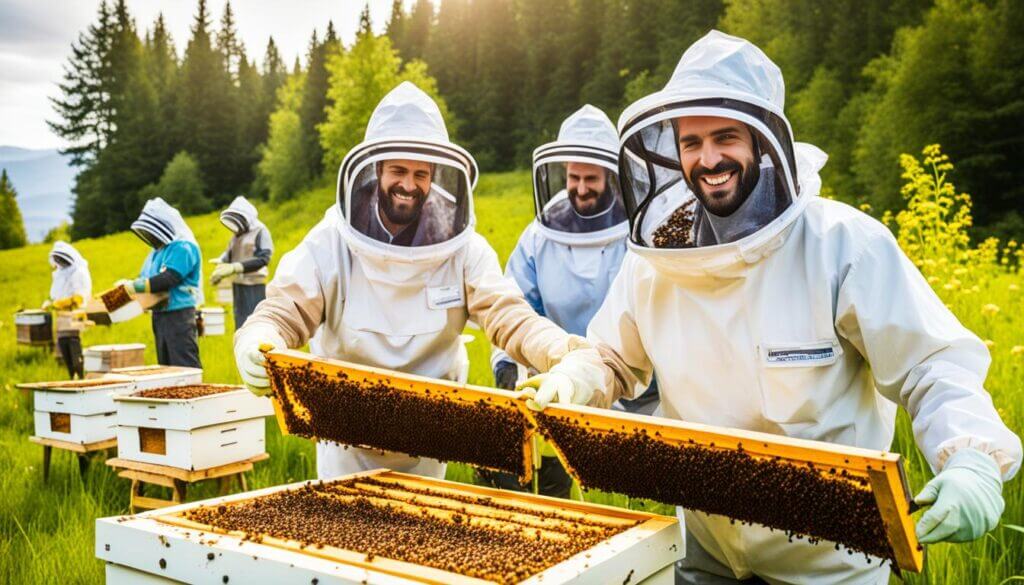
Beekeeping cooperatives have played a vital role in strengthening community ties and ensuring economic stability. These cooperatives function not just as business entities but as holistic institutions where knowledge, resources, and profits are shared for the collective good. By distributing the benefits derived from the Manuka honey market, these cooperatives contribute to sustainable development and environmental stewardship.
| Impact | Benefits |
|---|---|
| Economic Growth | Increased income from Manuka honey exports has fueled local economies. |
| Education | Cooperatives often reinvest in education, enhancing beekeeping skills and knowledge. |
| Empowerment | Indigenous populations have gained a voice and representation in the industry. |
| Environmental Conservation | Sustainable beekeeping practices have been implemented to protect native ecosystems. |
Moreover, the rise in visibility and profitability of Manuka honey has led to larger societal benefits, particularly for indigenous Maori communities. These groups have found a way to assert their rights and utilize their ancestral lands in ways that align with their traditional values and respect for nature. Sustainable practices are the cornerstone of their operations, ensuring that the environment is preserved for future generations while providing a stable and lucrative source of income.
- Increased Job Opportunities
- Revitalization of Rural Areas
- Enhanced Biodiversity through Responsible Beekeeping
In conclusion, the boon of the Manuka honey industry has become a catalyst for prosperity and unity within local communities. As these communities continue to flourish, the hope is that the model set by the Manuka honey economy can be a beacon for other industries seeking to combine commercial success with communal well-being and environmental health.
Conclusion
In the panorama of artisanal food production, Manuka honey beekeeping shines as a testament to the harmonious blend of tradition and innovation. Throughout this exploration of the processes, practices, and cultural significance, we’ve unearthed the tenacity and passion that fuels this industry. From the symbiotic relationship between the bees and the Manuka bush to the nuanced art of ethical harvesting, each step reinforces the importance of beekeeping to Manuka honey’s revered quality.
Looking to the horizon, the future of beekeeping is alight with potential. As the global community grows ever more conscientious about the origin and integrity of their food, Manuka honey’s value is destined to climb. As we’ve discussed, the health benefits and rare quality of Manuka honey set it apart, contributing to its respected stature on the global stage. With the evolution of beekeeping practices and emerging honey industry trends leaning towards sustainability and environmental accountability, Manuka honey producers are poised for continued success.
It is the dance between the enduring allure of Manuka honey and the tireless dedication of beekeepers that crafts the compelling narrative of this industry. The summary of Manuka honey beekeeping encapsulates more than just a product; it narrates a chronicle of ecological stewardship, community empowerment, and the boundless prospects that lie within the hives of New Zealand. As the world leans into the embrace of natural remedies and sustainable agriculture, Manuka honey and its guardians stand ready to meet the call, shaping a sweet future for us all.

